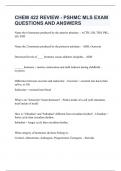CHEM 422 REVIEW - PSHMC MLS EXAM
QUESTIONS AND ANSWERS
Name the 6 hormones produced by the anterior pituitary: - ACTH, GH, TSH, PRL,
LH, FSH
Name the 2 hormones produced by the posterior pituitary: - ADH, Oxytocin
Decreased levels of ____ hormone causes diabetes insipidus. - ADH
______ hormone = uterine contractions and milk letdown during childbirth -
oxytocin
Difference between exocrine and endocrine: - Exocrine = secreted into ducts (like
saliva, or GI)
Endocrine = secreted into blood
What is an "intracrine" factor/hormone? - Works inside of a cell (cell stimulates
itself inside of itself)
How is "Ultradian" and "Infradian" different from circadian rhythm? - Ultradian =
faster cycle than circadian rhythm.
Infradian = longer cycle than circadian rhythm.
What category of hormones do these belong in:
Cortisol, Aldosterone, Androgens, Progesterone, Estrogens. - Steroids
,What category of hormones do these belong in: ACTH, TSH, FSH, LH, PRL, GH,
HCG, PTH, ADH, Oxytocin. - Protein/polypeptides
What category of hormones do these belong in: T3, T4, Catecholamine, Serotonin.
- Amino acid-derived
What class of hormones are hydrophobic, pass freely through membrane, and bind
with intracellular receptors? - Steroids
What class of horomones circulate freely (unbound to protein), bind cell membrane
surface receptors, and stimulate another messenger system inside the target cell? -
Protein/polypeptides
What class of proteins circulate bound to proteins (and sometimes freely) and bind
to cell membrane receptors to stimulate another messenger system inside the target
cell? - Amino acid-derived
_____ from hypothalamus stimulates pituitary to produce _____, which stimulates
adrenal cortex to produce steroid hormones (such as cortisol). - CRH
(corticotropin-releasing hormone), ACTH
Steroids are made from _______. - Cholesterol
Cortisol, aldosterone, testosterone, and estradiol are all a type of _____. - steroid
What is the term used for a disorder when the cause is due to medical treatment
(ex: wrong dose given)? - Iatrogenic
Relative hypersecretion of ADH = likely ________. - dehydration
,What is "Syndrome of Inappropriate ADH" (SIADH)? - When ADH is elevated
even though serum osmolality and blood volume is NL (can be due to tumors
producing ADH, or due to drugs)
What is panhypopituitarism? - Problem with the anterior pituitary with decreased
levels of all the pituitary hormones. an be due to tumors, surgery, SHEEHAN
SYNDROM, SIMMOND'S disease, etc.
What is Simmond's Disease? - Damage (surgery, tumor, infection, injury) to
pituitary. Symptoms = extreme weight loss, general debility, dry skin,
bradycardia,hypotension, atrophy of the genitalia and breasts, and
prematuresenility
What is Sheehan's syndrome? - Pituitary infarction after a postpartum hemorrhage
(a clot breaks off and migrates to pituitary gland -> hypoxic). Causes failure to
lactate (reduced prolactin) and postpartum amenorrhea.
Which cells in the thyroid are the secretory cells (secrete T3/T4)? - Follicular cells
The colloid in the thyroid is surrounded by follicular cells and is mostly composed
of ______. - Thyroglobulin
Which cells cluster along the interfollicular spaces in the thyroid and help regulate
Ca, Phos, and produce calcitonin? - Parafollicular cells (C cells)
Restlessness and insomnia can occur from overproduction of what hormones? -
Thyroid hormones
, Low _________ levels in pregnant women may increase the risk of miscarriage,
premature delivery, anemia, postpartum hemorrhage, and pre-eclampsia. Also
causes post-partum depression. - thyroid (T3/4)
What organ uses 90% of the body's iodine? - Thyroid
When TSH stimulates the thyroid, which 4 molecules/hormones are released? - T3,
T4, DIT (diiodotyrosine), and MIT (monoiodotyrosine). More T4 is secreted than
T3.
How is most of the T3 in the body made? - peripheral conversion
Diiodotyrosine/DIT gets converted to ___ wile monoiodotyrosine/MIT gets
converted to ___. - T4, T3
Does T3 or T4 have the most metabolic activity? - T3
Most of the serum T3 and T4 are ____ (free/bound to protein) - bound to proteins
(inactive)
Ex: thyroxine-binding globulin (TBG), thyroxine-binding albumin (TBA),
transthyretin (TTR), or thyroxine-binding prealbumin (TBPA)
Free T4 is usually ___% and T3 is ___% - 0.03, 0.5
Clinical conditions that influence hepatic production or renal clearance of binding
proteins will affect levels of _____ (free/total) thyroid hormones but not the _____
(free/total) hormones. - total, free




